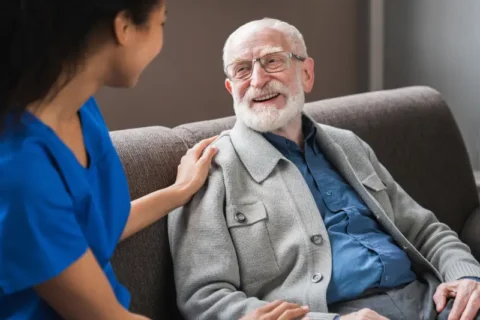Visiting Someone in Hospice
Tips for Visiting Someone in Hospice
Visiting a loved one in hospice is nothing short of emotional. As you prepare to visit, you might have lots of questions about what you should say and how you should act around your loved one and other family members who may be present. It’s natural to feel unsure, but remember that your presence is often what matters most. Here’s our practical guide for navigating hospice visits with sensitivity and care.
Preparing for Your Hospice Visit
Let’s start with how to prepare to visit someone in hospice. The first step is always to check in with your loved one’s primary caregiver. A quick call or text can ensure your timing is appropriate and the person feels up to having visitors. Put the ball in their court by asking which dates and times would be ideal for a visit. Other ways to prepare include:
- Focus on Short Visits—If this is a loved one you’re very close to, you might want to have a long visit. However, patients in hospice can quickly become fatigued. We recommend planning for shorter visits between 15 and 30 minutes unless their energy allows for more. Ask how they feel during the visit and wrap it up quickly if they seem sleepy or withdrawn.
- Bring Small Comforts—A thoughtful item or gift can brighten someone’s day. Consider bringing photos or mementos to reflect on happy memories. Warm blankets and cozy socks also make excellent gifts. If you want to bring a favorite snack or drink, be sure to check dietary restrictions with a caregiver first.
What to Do During Your Visit
No matter how prepared you are for a hospice visit, you might still feel uneasy about the experience. Here are our tips for ensuring everyone is comfortable during your visit:
Be Yourself, but Mind Your Tone
Your loved one doesn’t expect you to have all the answers or say the perfect thing. Simply being yourself is comforting. Speak with a calm, steady tone, and try to avoid overly loud or somber tones. Following their energy level will help guide the vibe of the conversation.
Listen More, Talk Less
Many patients find comfort in reminiscing. Give them space to share stories, memories, or feelings. And remember, sometimes silence is golden too. Listening with full attention is one of the simplest yet most meaningful gifts you can offer.
Share Positivity, Not Pity
If they want to talk about happy memories or life outside hospice, engage with enthusiasm. Avoid phrases like “Everything happens for a reason” or “I feel sorry for you.” These can come off as patronizing. Instead, focus on happy memories and reminiscing.
Respect Physical Boundaries and Comfort Levels
Sometimes, a hug or comforting touch can be just what we need. However, if you plan to use touch as a comforting gesture, proceed with caution. While it can mean a lot, make sure they’re never uncomfortable. If your loved one isn’t open to touch, focus on providing emotional presence rather than physical comfort.
Navigating the Difficult Moments
Even the most positive of hospice visits are likely to have some difficult moments. It’s completely normal to feel sadness or grief. After all, end-of-life care isn’t an easy pill to swallow. Try these strategies for navigating the tough times during your visit:
Be Honest About Not Knowing What to Say
Don’t know what to say to your loved one? This is understandable. Instead of ignoring this, try expressing your feelings honestly. You could say something like, “I’m not sure what to say right now, but I care about you.” Your sincerity matters!
Follow Their Lead
Every hospice patient is different. Some want to talk about the future, while others focus on the present. Pay attention to their cues and engage in topics they seem comfortable discussing. Never force conversations about their health or emotions.
Allow Yourself to Be Emotional, But Stay Grounded
Visiting someone in hospice is bound to stir up emotions. It’s okay to shed a tear but do your best to stay composed. By remaining calm, you’ll create a sense of security and strength for your loved one. If your emotions feel overwhelming, step out to collect yourself, or try journaling after your visit to process your thoughts.
We’re With You Every Step of the Way
Whether you’re visiting once a week or seeing your loved one in hospice every day, Agape Hospice & Palliative Care is here for you. Over the years, we’ve provided in-home end-of-life care to dozens of patients in Los Angeles and Orange Counties. Our team is here to make your visit as positive as possible, so don’t hesitate to let us know about any concerns you may have. We’re honored to be part of your support system during this difficult time. Contact us today to learn more.


